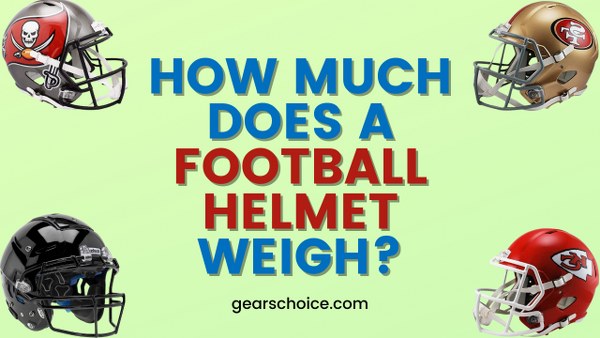How Much Does A Football Helmet Weigh?
Football helmets are available in different weights for adult and younger players.
It is generally seen that a helmet weighs in between the range of 2.0 to 6.0 pounds for adult football players and 1.5 to 3.0 pounds for younger football players.
These are the standard weight benchmarks that the manufacturing companies follow.
Another version of a football helmet weighs between 2.4 to 2.6 pounds, and a former racing car driver designed them; yes, we are talking about Bill Simpson!
Here you can know why weight matters while producing football helmets. They should neither be of too much low nor high weight.
Players can conveniently play high-intensity matches if their helmets weigh according to the standard benchmarks.
Overall, the helmet design and weight should be compatible with the player’s head size and physique.
Young players are more comfortable wearing lightweight helmets and expert-level players tend to prefer heavy helmets more.

Significance of football helmet’s weight
The weight of a helmet has always been of critical significance for football players. If a younger player has worn a heavy helmet, he will remain uncomfortable during the whole gameplay.
His ability to perform well on the ground will be negatively affected and not consistent if the helmet weight is too much for his head size.
In addition, the player and his game plan might come under stress if he is asked to wear a heavy helmet.
Heavy helmets worn by younger players increase the likelihood of getting an intense strain right in their head and neck muscles.
Moreover, if your helmet is inappropriately weighed, your performance on the sports ground will not come out optimum.
Are heavier football helmets comparatively more safe and sound?
All those helmets accompanied by a comparatively better protection mechanism and encased with advanced features tend to be more safe and more sound to wear.
In addition, such helmets weigh more, and sports players highly prefer them. Heavy helmets come with additional padding and stronger facemasks.
They keep your face, head, and neck protected while on the ground. Helmets weighing less fail to keep your facial features and neck muscles protected, and there is a probability that you might get injured during the game if you wear lightweight helmets.
Professional football players use helmets that weigh more, which is a common practice seeing nowadays.
Such helmets keep you protected from having brain trauma, and minor injuries and prevent skull fractures during football matches.
How do the latest football helmet models look like?
The latest helmet models are modeled, designed, and developed around a helmet initially conceptualized by Bill Simpson, one of the famous car racing drivers.
He even introduced fire-resistant suits for players into the car racing niche.
Bill believed that football players wearing light helmets make them an easy target and highly vulnerable to head and neck injuries.
So, he designed a kind of football helmet that aims to guard the player as long as he is on the sports field.
His product was marketed and advertised as SG Helmets, and their main purpose was to keep the player protected against skull fractures, head, and neck muscle injuries.
These new helmets were not heavyweight or lightweight; they were precisely balanced.
Construction of the latest football helmet models
Traditional helmets used hard plastic, but the latest models are made of Carbon Kevlar.
Such kind of material makes them more flexible. In addition, they tend to absorb more force, shock, and impact with ease.
Carbon Kevlar is comparatively a lighter weight material, and these helmets weigh between 2.4 to 2.6 pounds for adults and 1.8 pounds for younger players.
Most importantly, the latest models prevent concussions, avoid minor injuries and end up giving the player a protective barrier against neck and skull fractures.
Such helmets have come out as the most substantive and thoughtful innovations for football players.
If the helmet weight is according to the player’s head size, it gets easy to keep his head up and focus better on his gameplay.
The lightweight nature of helmets will discourage players from hitting their heads.
Thus, it is hoped that more innovation will occur while designing helmets for football players.
Try making the sports ground a safer place where the player keeps his head, skull, and neck protected by wearing a good-quality helmet and not smashing or hitting other players.
Football helmets weight- the matter of crucial importance
Thus, the bottom line is that a football helmet should weigh from 2.0 to 6.0 pounds for adult players and 1.5 to 3.0 pounds for younger sports players.
Experts believe that the additional weight on the head negatively affects the player’s game; that is why this standard should be followed.
Besides, more innovation and flexibility are needed while designing football helmets.
A combination of medical research and technology is needed to guard the player against skull, neck, and head injuries during the gameplay.
If the helmet size and weight does not match appropriately to the player’s head physique, he will remain unfocused during the entire time he is playing football.
The weight of NFL helmets
There is an interesting stat about NFL helmets! They weigh between 4.25 and 4.75 pounds. In addition, their shoulder pads weigh in the range of 4 to 5 pounds, and the jersey and pants are about a pound.
Thus, a typical helmet weighs between 1400 to 1800 grams. If its weight reaches and extends about 1650 grams, it tends to become harder and more challenging to mask its weight.
Conclusion
You need to understand that even an ounce of difference in terms of the helmet’s weight massively affects the player’s game.
If you are new to this football sport and looking for an effective-looking helmet, make sure it matches your head size and physique.
Besides, it should not bring discomfort while you are in the field. There are various football helmet sizes and weights for different age groups; choose the one that does not suffer your performance.
Stay tuned to get more of the details.

Hi, I’m James Dean. My motorbike obsession started at age seven with a 50cc bike, and I’ve been riding ever since.
From motocross in my teens to cruising and snowmobiling today, I’ve got over 15 years of experience.
As a mechanical engineer and passionate rider, I founded gearschoice.com to share my insights and help you find the best motorcycle gear.

![How To Clean A Motorcycle Helmet Visor? [Simple 9 Steps] 3 How To Clean A Motorcycle Helmet Visor](https://gearschoice.com/wp-content/uploads/2022/02/How-To-Clean-A-Motorcycle-Helmet-Visor-768x432.jpg)




